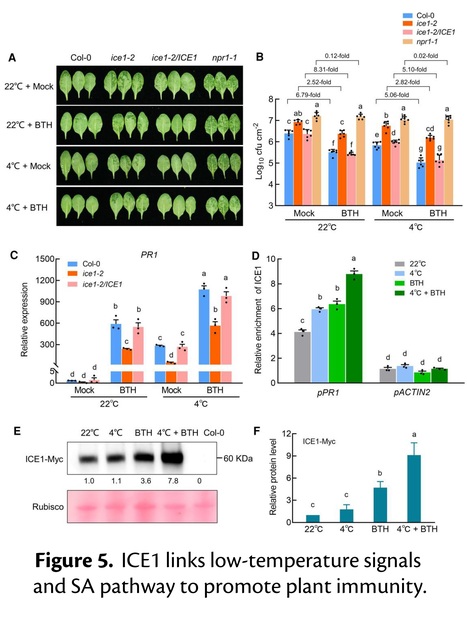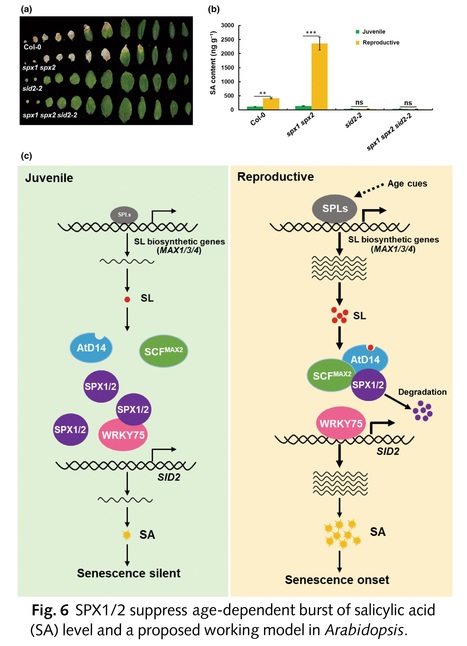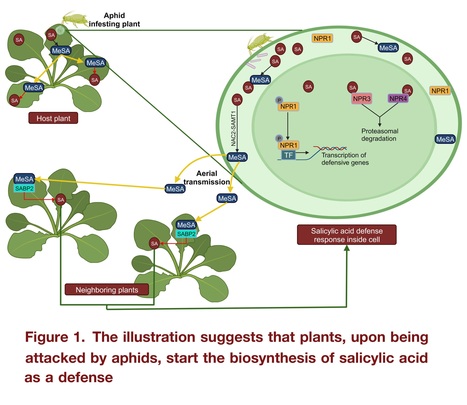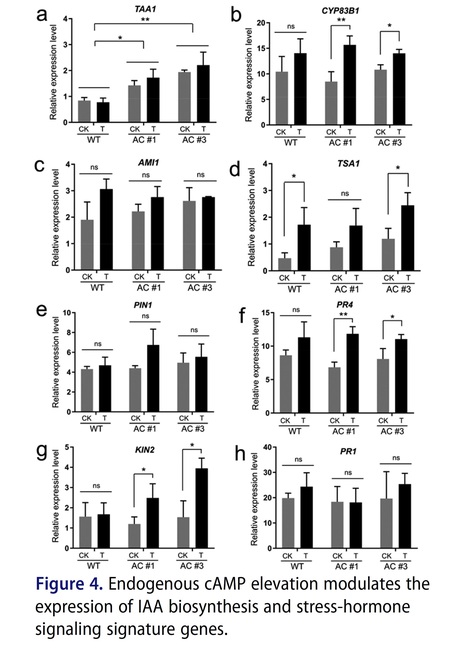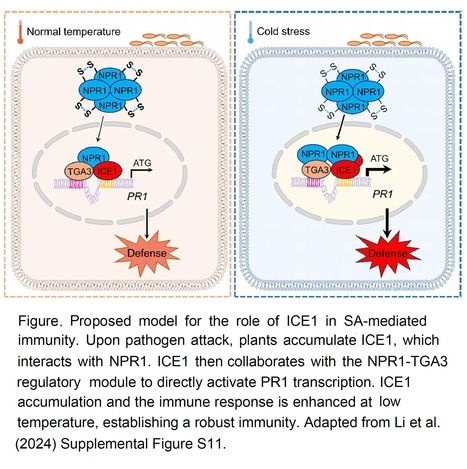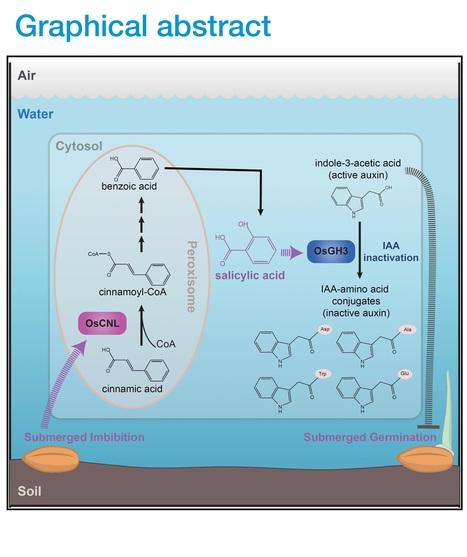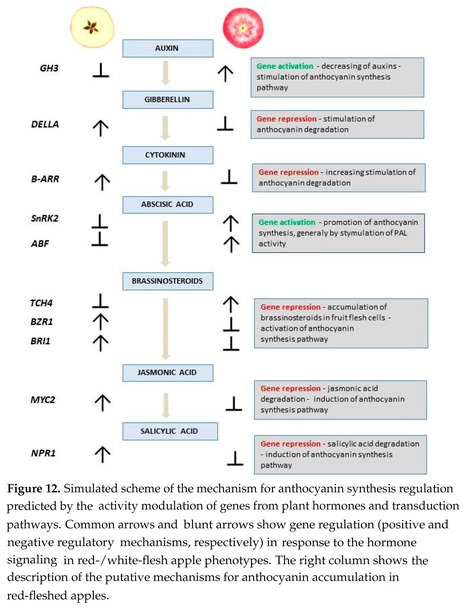 Your new post is loading...
 Your new post is loading...
Authors: Ishfaq Majid Hurrah, Amit Kumar and Nazia Abbas.
Planta (2024)
Main conclusion: Overexpression of Artemisia annua jasmonic acid carboxyl methyltransferase (AaJMT) leads to enhanced artemisinin content in Artemisia annua.
Abstract: "Artemisinin-based combination therapies remain the sole deterrent against deadly disease malaria and Artemisia annua remains the only natural producer of artemisinin. In this study, the 1101 bp gene S-adenosyl-l-methionine (SAM): Artemisia annua jasmonic acid carboxyl methyltransferase (AaJMT), was characterised from A. annua, which converts jasmonic acid (JA) to methyl jasmonate (MeJA). From phylogenetic analysis, we confirmed that AaJMT shares a common ancestor with Arabidopsis thaliana, Eutrema japonica and has a close homology with JMT of Camellia sinensis. Further, the Clustal Omega depicted that the conserved motif I, motif III and motif SSSS (serine) required to bind SAM and JA, respectively, are present in AaJMT. The relative expression of AaJMT was induced by wounding, MeJA and salicylic acid (SA) treatments. Additionally, we found that the recombinant AaJMT protein catalyses the synthesis of MeJA from JA with a Km value of 37.16 µM. Moreover, site-directed mutagenesis of serine-151 in motif SSSS to tyrosine, asparagine-10 to threonine and glutamine-25 to histidine abolished the enzyme activity of AaJMT, thus indicating their determining role in JA substrate binding. The GC–MS analysis validated that mutant proteins of AaJMT were unable to convert JA into MeJA. Finally, the artemisinin biosynthetic and trichome developmental genes were upregulated in AaJMT overexpression transgenic lines, which in turn increased the artemisinin content."
Authors: André Kessler and Michael B. Mueller.
Plant Signaling & Behavior (2024)
Abstract: "Plant induced responses to environmental stressors are increasingly studied in a behavioral ecology context. This is particularly true for plant induced responses to herbivory that mediate direct and indirect defenses, and tolerance. These seemingly adaptive alterations of plant defense phenotypes in the context of other environmental conditions have led to the discussion of such responses as intelligent behavior. Here we consider the concept of plant intelligence and some of its predictions for chemical information transfer in plant interaction with other organisms. Within this framework, the flow, perception, integration, and storage of environmental information are considered tunable dials that allow plants to respond adaptively to attacking herbivores while integrating past experiences and environmental cues that are predictive of future conditions. The predictive value of environmental information and the costs of acting on false information are important drivers of the evolution of plant responses to herbivory. We identify integrative priming of defense responses as a mechanism that allows plants to mitigate potential costs associated with acting on false information. The priming mechanisms provide short- and long-term memory that facilitates the integration of environmental cues without imposing significant costs. Finally, we discuss the ecological and evolutionary prediction of the plant intelligence hypothesis."
Authors: Shaoqin Li, Li He, Yongping Yang, Yixin Zhang, Xiao Han, Yanru Hu and Yanjuan Jiang.
The Plant Cell (2024)
One-sentence summary: The NPR1–TGA3–ICE1 regulatory module represents an important step in salicylic acid signaling during cold-activated resistance of plants to pathogen attack.
Abstract: "Cold stress affects plant immune responses, and this process may involve the salicylic acid (SA) signaling pathway. However, the underlying mechanism by which low-temperature signals coordinate with SA signaling to regulate plant immunity remains unclear. Here, we found that low temperatures enhanced the disease resistance of Arabidopsis thaliana against Pseudomonas syringae pv. tomato DC3000. This process required INDUCER OF CBF EXPRESSION 1 (ICE1), the core transcription factor in cold-signal cascades. ICE1 physically interacted with NONEXPRESSER OF PATHOGENESIS-RELATED GENES 1 (NPR1), the master regulator of the SA signaling pathway. Enrichment of ICE1 on the PATHOGENESIS-RELATED GENE 1 (PR1) promoter and its ability to transcriptionally activate PR1 were enhanced by NPR1. Further analyses revealed that cold stress signals cooperate with SA signals to facilitate plant immunity against pathogen attack in an ICE1-dependent manner. Cold treatment promoted interactions of NPR1 and TGACG-BINDING FACTOR 3 (TGA3) with ICE1 and increased the ability of the ICE1–TGA3 complex to transcriptionally activate PR1. Together, our results characterize a critical role of ICE1 as an indispensable regulatory node linking low-temperature-activated and SA-regulated immunity. Understanding this crucial role of ICE1 in coordinating multiple signals associated with immunity broadens our understanding of plant–pathogen interactions."
Authors: Yexing Jing, Ziyi Yang, Zongju Yang, Wanqing Bai, Ruizhen Yang, Yanjun Zhang, Kewei Zhang, Yunwei Zhang and Jiaqiang Sun.
New Phytologist (2024)
Abstract: "Leaf senescence is a complex process strictly regulated by various external and endogenous factors. However, the key signaling pathway mediating leaf senescence remains unknown. Here, we show that Arabidopsis SPX1/2 negatively regulate leaf senescence genetically downstream of the strigolactone (SL) pathway. We demonstrate that the SL receptor AtD14 and MAX2 mediate the age-dependent degradation of SPX1/2. Intriguingly, we uncover an age-dependent accumulation of SLs in leaves via transcriptional activation of SL biosynthetic genes by the transcription factors (TFs) SPL9/15. Furthermore, we reveal that SPX1/2 interact with the WRKY75 subclade TFs to inhibit their DNA-binding ability and thus repress transcriptional activation of salicylic acid (SA) biosynthetic gene SA Induction-Deficient 2, gating the age-dependent SA accumulation in leaves at the leaf senescence onset stage. Collectively, our new findings reveal a signaling pathway mediating sequential activation of SL and salicylate biosynthesis for the onset of leaf senescence in Arabidopsis."
Authors: Xiaofang Li, Xin Zheng, Nikita Yadav, Shouvik Saha, El-Sayed Salama, Xiangkai Li, Likun Wang and Byong-Hun Jeon.
Plant Communications (2024)
Abstract: The Green Revolution of the mid-20th century transformed agriculture worldwide and has resulted in environmental challenges. A new approach, the Second Green Revolution, seeks to enhance agricultural productivity while minimizing negative environmental impacts. Plant microbiomes play critical roles in plant growth and stress responses, and understanding plant–microbiome interactions is essential for developing sustainable agricultural practices that meet food security and safety challenges, which are among the United Nations Sustainable Development Goals. This review provides a comprehensive exploration of key deterministic processes crucial for developing microbiome management strategies, including the host effect, the facilitator effect, and microbe–microbe interactions. A hierarchical framework for plant microbiome modulation is proposed to bridge the gap between basic research and agricultural applications. This framework emphasizes three levels of modulation: single-strain, synthetic community, and in situ microbiome modulation. Overall, rational management of plant microbiomes has wide-ranging applications in agriculture and can potentially be a core technology for the Second Green Revolution."
Authors: Mervin Chun-Yi Ang, Jolly Madathiparambil Saju, Thomas K. Porter, Sayyid Mohaideen, Sreelatha Sarangapani, Duc Thinh Khong, Song Wang, Jianqiao Cui, Suh In Loh, Gajendra Pratap Singh, Nam-Hai Chua, Michael S. Strano and Rajani Sarojam.
Nature Communications (2024)
Editor's view: Upon stress, plants activate a signaling cascade leading to resistance or stress adaptation. Here, Ang & Saju et al. use sensor multiplexing to elucidate the interplay between H2O2 and SA signaling as plants mount stress-specific defense responses.
Abstract: "Increased exposure to environmental stresses due to climate change have adversely affected plant growth and productivity. Upon stress, plants activate a signaling cascade, involving multiple molecules like H2O2, and plant hormones such as salicylic acid (SA) leading to resistance or stress adaptation. However, the temporal ordering and composition of the resulting cascade remains largely unknown. In this study we developed a nanosensor for SA and multiplexed it with H2O2 nanosensor for simultaneous monitoring of stress-induced H2O2 and SA signals when Brassica rapa subsp. chinensis (Pak choi) plants were subjected to distinct stress treatments, namely light, heat, pathogen stress and mechanical wounding. Nanosensors reported distinct dynamics and temporal wave characteristics of H2O2 and SA generation for each stress. Based on these temporal insights, we have formulated a biochemical kinetic model that suggests the early H2O2 waveform encodes information specific to each stress type. These results demonstrate that sensor multiplexing can reveal stress signaling mechanisms in plants, aiding in developing climate-resilient crops and pre-symptomatic stress diagnoses."
Authors: Jana Jarošová, Sylva Prerostova, Martin Černý, Petre Dobrev, Alena Gaudinova, Vojtech Knirsch, Eva Kobzová, Karel Müller, Roman Fiala, Kinga Benzcúr, Gabriella Szalai, Jan Novák, Břetislav Brzobohatý, Ondrej Novak and Radomira Vankova.
Environmental and Experimental Botany (2024)
Highlights: • Targeted stresses affected proteins predominantly in the non-exposed organs • Abscisic acid in roots after all cold treatments regulated hydraulic conductivity • Jasmonates in stressed leaves might diminish stress effects on photosynthesis • Salicylic acid probably enhanced sugar unloading from phloem in roots under stress • Pre-acclimation enhanced stress tolerance, and speeded up recovery
Abstract: "Rice is a plant species sensitive to cold stress, which renders seriously its cultivation. Responses to cold stress (5°C, 24 hours) in whole plants, or targeted to rice leaves or roots were followed at the hormonome, transcriptome, proteome, and sugar levels, to find organ-specific responses and processes affected by cold acclimation. Targeted stresses caused proteomic changes mainly in the unexposed organs. An increase in abscisic acid (ABA) was accompanied by a decrease in jasmonic acid (JA) (in roots and non-stressed leaves) and vice versa (JA increased in stressed leaves). Both hormones promote the cold tolerance of plants. In this way, JA could indirectly reduce negative effects of cold on photosynthesis in leaves, while ABA dominates in roots (stimulation of protective substances, especially dehydrins, control of water regime). The decrease in cytokinins trans-zeatin and dihydrozeatin in crowns correlated with stress-induced growth suppression. Leaf-targeted cold stress impaired photosynthesis and decreased sugar levels, diminishing their transport, which correlated with an increase in salicylic acid, which is a signal for sugar unloading from phloem into roots. Root-targeted stress suppressed cytokinin biosynthesis and upward transport, and promoted sugar accumulation in leaves. Acclimation per se activated the transcriptome and proteome response to cold –ABA, JA and ethylene were upregulated, moderately suppressing plant growth. Pre-acclimated plants showed less profound hormonal changes than directly stressed plants, positively affecting levels of growth-related phytohormones in the unexposed organs (cytokinins in roots of leaf-stressed plants; auxins in leaves of root-stressed plants)."
Authors: Foziya Altaf, Shazia Parveen, Sumira Farooq, Mohammad Lateef Lone, Aehsan Ul Haq and Inayatullah Tahir
Theoretical and Experimental Plant Physiology (2024)
Abstract: "Due to the already strained and severely challenged agricultural ecosystems of the modern world, predicted changes in life cycle of plants, including leaf senescence are receiving significant attention from stakeholders. The onset, progression and terminal phases of leaf senescence are greatly influenced by plant hormones. The senescence of leaves is accelerated by ethylene, jasmonic acid (JA), salicylic acid (SA), abscisic acid (ABA), brassinosteroids and strigolactones (SLs), whereas it is postponed by cytokinins (CKs), gibberellic acid (GA) and auxins. The crosstalk and signal transduction pathways between these growth regulators have been found to regulate leaf senescence by orchestrating various developmental and environmental factors. Premature leaf senescence lessens the plant’s nutritional capacity and shortens the vegetative production schedule, prompting an early transition from the vegetative to the reproductive stage and diminishing crop potential. As a result, a complete understanding of leaf senescence and finding novel ways to delay it is crucial for agricultural productivity. The ability to manipulate leaf senescence for agricultural enhancement has been made possible by significant advances in physiological and molecular awareness of leaf senescence. Although studies pertaining to leaf senescence have been given steadily more attention, there are still numerous challenges that need to be resolved. In this perspective, this review focuses on current advances in understanding the leaf senescence by molecular and genetic analyses with an emphasis on hormonal regulation of leaf senescence. We also hypothesize future research to better comprehend leaf senescence by employing various current technologies."
Authors: Saumya Jaiswal, Durgesh Kumar Tripathi, Ravi Gupta, Jing He, Zhong-Hua Chen and Vijay Pratap Singh.
Journal of Integrative Plant Biology (2024)
Editor's view: After being infested by aphids, plants trigger a signaling pathway that involves methyl salicylate as an airborne signaling molecule. Thus, the regulation of communication for systemically acquired resistance produced via methyl salicylate is helpful in generating stress resistance among plants against aphid infestation.
Excerpts: "In this commentary, we discuss the signaling role of methyl-salicylate (MeSA) under attack by members of Aphidoidea in plants, which brings about systemically acquired resistance in the aphid-infested plant as well as neighboring plants by acting as a long-distance signaling molecule."
"On the other hand, elevated salicylic acid levels activate the Nicotiana benthamiana transcription factor 2 (NAC2), which gets attached to the promotor region of SAMT1 to activate its transcription process, resulting in conversion of salicylic acid into MeSA. MeSA is transferred via phloem to other plant parts or received by neighboring plants through some specific receptor-like salicylic acid binding protein 2 (SABP2), which also regulates the reconversion of MeSA into salicylic acid to generate specific response against pathogens and insects (Chen et al., 2020; Gong et al., 2023)."
"Although plants are proficient in responding to various environmental cues, MeSA is reported as the key player for interactions among neighboring plants as it is highly aquaphobic and volatile, more so than salicylic acid, along with generating the systemically adapted resilience in plants affected with aphids (Gong et al., 2023). Being a VOC, MeSA can be transferred aerially to neighboring plants in a species-specific manner to produce airborne defense (Gondor et al., 2022)."
Authors: Tianming Li, Wenjing Jia, Song Peng, Yanhui Guo, Jinrui Liu, Xue Zhang, Panyu Li, Hanfeng Zhang and Ruqiang Xu.
Plant Signaling & Behavior (2024)
Abstract: "In higher plants, the regulatory roles of cAMP (cyclic adenosine 3′,5′-monophosphate) signaling remain elusive until now. Cellular cAMP levels are generally much lower in higher plants than in animals and transiently elevated for triggering downstream signaling events. Moreover, plant adenylate cyclase (AC) activities are found in different moonlighting multifunctional proteins, which may pose additional complications in distinguishing a specific signaling role for cAMP. Here, we have developed rapeseed (Brassica napus L.) transgenic plants that overexpress an inducible plant-origin AC activity for generating high AC levels much like that in animal cells, which served the genetic model disturbing native cAMP signaling as a whole in plants. We found that overexpression of the soluble AC activity had significant impacts on the contents of indole-3-acetic acid (IAA) and stress phytohormones, i.e. jasmonic acid (JA), abscisic acid (ABA), and salicylic acid (SA) in the transgenic plants. Acute induction of the AC activity caused IAA overaccumulation, and upregulation of TAA1 and CYP83B1 in the IAA biosynthesis pathways, but also simultaneously the hyper-induction of PR4 and KIN2 expression indicating activation of JA and ABA signaling pathways. We observed typical overgrowth phenotypes related to IAA excess in the transgenic plants, including significant increases in plant height, internode length, width of leaf blade, petiole length, root length, and fresh shoot biomass, as well as the precocious seed development, as compared to wild-type plants. In addition, we identified a set of 1465 cAMP-responsive genes (CRGs), which are most significantly enriched in plant hormone signal transduction pathway, and function mainly in relevance to hormonal, abiotic and biotic stress responses, as well as growth and development. Collectively, our results support that cAMP elevation impacts phytohormone homeostasis and signaling, and modulates plant growth and development. We proposed that cAMP signaling may be critical in configuring the coordinated regulation of growth and development in higher plants."
Authors; Kohji Yamada and Akira Mine.
Science Advances (2024)
One-sentence summary: In plants, the types and amplitudes of defense outputs against bacterial and fungal pathogens depend on cellular sugars.
Abstract: "Pathogen recognition triggers energy-intensive defense systems. Although successful defense should depend on energy availability, how metabolic information is communicated to defense remains unclear. We show that sugar, especially glucose-6-phosphate (G6P), is critical in coordinating defense in Arabidopsis. Under sugar-sufficient conditions, phosphorylation levels of calcium-dependent protein kinase 5 (CPK5) are elevated by G6P-mediated suppression of protein phosphatases, enhancing defense responses before pathogen invasion. Subsequently, recognition of bacterial flagellin activates sugar transporters, leading to increased cellular G6P, which elicits CPK5-independent signaling promoting synthesis of the phytohormone salicylic acid (SA) for antibacterial defense. In contrast, while perception of fungal chitin does not promote sugar influx or SA accumulation, chitin-induced synthesis of the antifungal compound camalexin requires basal sugar influx activity. By monitoring sugar levels, plants determine defense levels and execute appropriate outputs against bacterial and fungal pathogens. Together, our findings provide a comprehensive view of the roles of sugar in defense."
Authors: Yuli Du, Heng Zhang, Kunpeng Jia, Zongyan Chu, Shican Xu, Lam-Son Phan Tran, Jinggong Guo, Weiqiang Li and Kun Li.
Physiologia Plantarum (2024)
Abstract: "In terrestrial plants, stomata in the leaf epidermis formed by guard cells are the major pathways for gas exchange. However, opened stomata also provide a major channel for pathogen entry. At the pre-invasive stage, plants actively close stomata to prevent pathogen attack, which is termed stomatal immunity, and plant hormones are involved in this process. Here, we summarize recent advances in the role of abscisic acid (ABA) in promoting stomatal immunity to prevent pathogen entry. Additionally, salicylic acid shares common downstream elements with ABA to promote stomatal immunity, whereas reactive oxygen species and Ca2+ act as critical signals to cross-talk with ABA signalling to regulate stomatal movement, and they also enhance the effect of ABA in stomatal immunity. On the other hand, at the post-invasive stage, closed stomata create a water-soaked environment that allows pathogen multiplication, and ABA signalling is hijacked by pathogens to reduce stomatal aperture. Here, we propose a model of dual roles of ABA-mediated stomatal closure during plant-pathogen interaction and offer emerging consequences and questions for ABA-mediated stomatal immunity."
Authors: Steven H. Spoel and Xinnian Dong.
The Plant Cell (2024)
Abstract: "As the most widely used herbal medicine in human history and a major defense hormone in plants against a broad spectrum of pathogens and abiotic stresses, salicylic acid (SA) has attracted major research interest. With applications of modern technologies over the past 30 years, studies of the effects of SA on plant growth, development, and defense have revealed many new research frontiers, and continue to deliver surprises. In this review, we provide an update on recent advances in our understanding of SA metabolism, perception, and signal transduction mechanisms in plant immunity. An overarching theme emerges that SA executes its many functions through intricate regulation at multiple steps: SA biosynthesis is regulated both locally and systemically, while its perception occurs through multiple cellular targets, including metabolic enzymes, redox regulators, transcription cofactors, and most recently, an RNA-binding protein. Moreover, SA orchestrates a complex series of posttranslational modifications of downstream signaling components and promotes the formation of biomolecular condensates that function as cellular signaling hubs. SA also impacts wider cellular functions through crosstalk with other plant hormones. Looking into the future, we propose new areas for exploration on SA functions, which will undoubtedly uncover more surprises for many years to come."
|
Authors: Akbar Ali, Krishan Kant, Navneet Kaur, Shalu Gupta, Parnika Jindal, Sarvajeet Singh Gill and M. Naeem.
South African Journal of Botany (2024)
Highlights: • Salicylic acid (SA) has encouraging effects on the growth and development of plants. • SA stimulates signalling in plants via several stress proteins and genes. • SA positively interacts with other phytohormones. • SA enhances plant tolerance towards abiotic stress.
Abstract: "Drastic change in global climatic conditions has significantly increased the frequency of abiotic stresses, such as different temperature regimes (high, low, or freezing stress), uneven precipitation leading to flooding or drought, soil salinization, cyclones and hurricanes which pose a major challenge to the crop productivity and food security. Therefore, it becomes imperative for the global science community to engineer stress tolerance in crop plants to ensure enough food for the globe. Plant growth regulators play an important function in stress management. One putative plant hormone that aids plants in coping with biotic and abiotic stressors is salicylic acid (SA). SA also cooperates with other phytohormones, such as gibberellins, auxins, abscisic acid, jasmonic acid, ethylene, polyamines, nitric oxide, and to counter the negative effects of environmental perturbations. Moreover, SA shields plants from oxidative stress by reducing the production of reactive oxygen species in challenging circumstances. Additionally, SA stimulates gas exchange, photosynthesis, and osmolyte synthesis in plants, which counteract the damage caused by ROS. Exogenous application of SA to agricultural crops including medicinal and aromatic plants improves their abiotic stress tolerance, either individually or in combination with other phytohormones. SA can stimulate the production of secondary metabolites by controlling the expression of stress-related genes, activating or regulating several key enzymes, and balancing the ion content. The present review summarizes the various mechanisms by which SA confers abiotic stress tolerance in plants through homeostasis, signalling, and crosstalk with other phytohormones."
Author: Leiyun Yang
The Plant Cell (2024)
Excerpts: "Simultaneously, low temperature stimulates plant immunity by activating salicylic acid (SA)-mediated signaling (Wu et al. 2019). However, the mechanism by which plants integrate cold signals and immune signaling remain elusive. To investigate this question, Shaoqin Li and colleagues (Li et al. 2024) studied the potential involvement of ICE1 in cold-induced immunity in Arabidopsis."
"To elucidate how ICE1 regulates cold-induced immunity, the authors conducted a yeast-two-hybrid screen and identified NON-EXPRESSER OF PR GENES 1 (NPR1), a master transcriptional co-activator of PATHOGENESIS-RELATED GENE 1 (PR1) in SA-activated immunity, as an ICE1 interactor.....Additionally, the authors found that ICE1 directly binds to the PR1 promoter for gene activation. These results illustrate that ICE1 interacts with NPR1 and is required for SA-mediated immunity by directly promoting PR1 expression."
"These results support the conclusion that ICE1 and TGA3 work synergistically to promote PR1 transcription. This study not only shed light on a new role of ICE1 in SA-mediated immunity at low temperature, but also revealed NPR1-TGA3/ICE1 as an important nexus integrating SA signaling and cold signals in plant immunity (see Figure)."
Authors: Tingliang Xu, Xiaowen Zheng, Yi Yang, Shumin Yang, Xingwan Yi, Chao Yu, Le Luo, Jia Wang, Tangren Cheng, Qixiang Zhang and Huitang Pan.
Planta (2024)
Main conclusion: IAA cooperates with JA to inhibit SA and negatively regulates rose black spot disease resistance.
Abstract: "Black spot disease caused by the fungus Marssonina rosae is the most prevalent and severe ailment in rose cultivation, leading to the appearance of black spots on leaves and eventual leaf fall, significantly impacting the utilization of roses in gardens. Salicylic acid (SA) and jasmonic acid (JA) are pivotal hormones that collaborate with indole-3 acetic acid (IAA) in regulating plant defense responses; however, the detailed mechanisms underlying the induction of black spot disease resistance by IAA, JA, and SA remain unclear. In this study, transcript analysis was conducted on resistant (R13–54) and susceptible (R12–26) lines following M. rosae infection. In addition, the impact of exogenous interference with IAA on SA- and JA-mediated disease resistance was examined. The continuous accumulation of JA, in synergy with IAA, inhibited activation of the SA signaling pathway in the early infection stage, thereby negatively regulating the induction of effective resistance to black spot disease. IAA administration alleviated the inhibition of SA on JA to negatively regulate the resistance of susceptible strains by further enhancing the synthesis and accumulation of JA. However, IAA did not contribute to the negative regulation of black spot resistance when high levels of JA were inhibited. Virus-induced gene silencing of RcTIFY10A, an inhibitor of the JA signaling pathway, further suggested that IAA upregulation led to a decrease in disease resistance, a phenomenon not observed when the JA signal was inhibited. Collectively, these findings indicate that the IAA-mediated negative regulation of black spot disease resistance relies on activation of the JA signaling pathway."
Authors: Grace A. Johnston, Hannah M. Berry, Mikiko Kojima, Hitoshi Sakakibara and Cristiana T. Argueso.
bioRxiv (2024)
Abstract: "Plant immunity activation often results in suppression of plant growth, particularly in the case of constitutive immune activation. We discovered that signaling of the phytohormone cytokinin (CK), known to regulate plant growth through the control of cell division and shoot apical meristem (SAM) activity, can be suppressed by negative crosstalk with the defense phytohormones jasmonic acid (JA), and most evidently, salicylic acid (SA). We show that changing the negative crosstalk of SA on CK signaling in autoimmunity mutants by targeted increase of endogenous CK levels results in plants resistant to pathogens from diverse lifestyles, and relieves suppression of reproductive growth. Moreover, such changes in crosstalk result in a novel reproductive growth phenotype, suggesting a role for defense phytohormones in the SAM, likely through regulation of nitrogen response and cellular redox status. Our data suggest that targeted phytohormone crosstalk engineering can be used to achieve increased reproductive growth and pathogen resistance."
Authors: Yukang Wang, Gaochen Jin, Shuyan Song, Yijun Jin, Xiaowen Wang, Shuaiqi Yang, Xingxing Shen, Yinbo Gan, Yuexing Wang, Ran Li, Jian-Xiang Liu, Jianping Hu and Ronghui Pan.
Developmental Cell (2024)
Editor's view: Wang et al. demonstrated a peroxisomal cinnamate:CoA ligase (CNL)-dependent phytohormone metabolic cascade in rice. Submerged imbibition-induced salicylic acid (SA) biosynthesis promotes anaerobic germination by inducing OsGH3-mediated indole-acetic acid (IAA)-amino acid conjugation, thus releasing IAA’s inhibition of germination under water submergence conditions.
Highlights: • OsCNLs are induced in rice submerged imbibition to synthesize salicylic acid (SA) • Peroxisomal OsCNLs are key enzymes in the SA biosynthetic pathway in rice • SA promotes submerged germination via OsGH3-mediated indole-acetic acid catabolism • SA pretreatment is a cost-effective strategy to improve rice submerged germination
Abstract: "The mechanism underlying the ability of rice to germinate underwater is a largely enigmatic but key research question highly relevant to rice cultivation. Moreover, although rice is known to accumulate salicylic acid (SA), SA biosynthesis is poorly defined, and its role in underwater germination is unknown. It is also unclear whether peroxisomes, organelles essential to oilseed germination and rice SA accumulation, play a role in rice germination. Here, we show that submerged imbibition of rice seeds induces SA accumulation to promote germination in submergence. Two submergence-induced peroxisomal Oryza sativa cinnamate:CoA ligases (OsCNLs) are required for this SA accumulation. SA exerts this germination-promoting function by inducing indole-acetic acid (IAA) catabolism through the IAA-amino acid conjugating enzyme GH3. The metabolic cascade we identified may potentially be adopted in agriculture to improve the underwater germination of submergence-intolerant rice varieties. SA pretreatment is also a promising strategy to improve submerged rice germination in the field."
Authors: Dacheng Wang, Lirong Wei, Jinbiao Ma, Kenichi Tsuda, Chunhao Jiang and Yiming Wang.
Cell Reports (2024)
Editor's view: The plant microbiome helps to shape the immune system to counter infection of pathogens. Wang et al. show that the root-associated Bacillus cereus NJ01 significantly enhances plant resistance. The EDS1-WRKY18 module is required for NJ01-enhanced disease resistance through activation of SA- and ABA-mediated immunity.
Highlights: • Rhizobacterium Bacillus cereus NJ01 enhances plant resistance against bacterial pathogens • EDS1 enhances WRKY18 DNA-binding activity for the NJ01-enhanced disease resistance • ICS1 and NCED3/5 are downstream of EDS1-WRKY18 for NJ01-enhanced disease resistance
Abstract: "Emerging evidence suggests a beneficial role of rhizobacteria in ameliorating plant disease resistance in an environment-friendly way. In this study, we characterize a rhizobacterium, Bacillus cereus NJ01, that enhances bacterial pathogen resistance in rice and Arabidopsis. Transcriptome analyses show that root inoculation of NJ01 induces the expression of salicylic acid (SA)- and abscisic acid (ABA)-related genes in Arabidopsis leaves. Genetic evidence showed that EDS1, PAD4, and WRKY18 are required for B. cereus NJ01-induced bacterial resistance. An EDS1-PAD4 complex interacts with WRKY18 and enhances its DNA binding activity. WRKY18 directly binds to the W box in the promoter region of the SA biosynthesis gene ICS1 and ABA biosynthesis genes NCED3 and NCED5 and contributes to the NJ01-induced bacterial resistance. Taken together, our findings indicate a role of the EDS1/PAD4-WRKY18 complex in rhizobacteria-induced disease resistance."
Authors: Weiwei Cai, Yilin Tao, Xingge Cheng, Meiyun Wan, Jianghuang Gan, Sheng Yang, Thomas W. Okita, Shuilin He and Li Tian.
Plant Biotechnology Journal (2024)
Abstract: "To challenge the invasion of various pathogens, plants re-direct their resources from plant growth to an innate immune defence system. However, the underlying mechanism that coordinates the induction of the host immune response and the suppression of plant growth remains unclear. Here we demonstrate that an auxin response factor, CaARF9, has dual roles in enhancing the immune resistance to Ralstonia solanacearum infection and in retarding plant growth by repressing the expression of its target genes as exemplified by Casmc4, CaLBD37, CaAPK1b and CaRROP1. The expression of these target genes not only stimulates plant growth but also negatively impacts pepper resistance to R. solanacearum. Under normal conditions, the expression of Casmc4, CaLBD37, CaAPK1b and CaRROP1 is active when promoter-bound CaARF9 is complexed with CaIAA2. Under R. solanacearum infection, however, degradation of CaIAA2 is triggered by SA and JA-mediated signalling defence by the ubiquitin-proteasome system, which enables CaARF9 in the absence of CaIAA2 to repress the expression of Casmc4, CaLBD37, CaAPK1b and CaRROP1 and, in turn, impeding plant growth while facilitating plant defence to R. solanacearum infection. Our findings uncover an exquisite mechanism underlying the trade-off between plant growth and immunity mediated by the transcriptional repressor CaARF9 and its deactivation when complexed with CaIAA2."
Authors: Cheng Zhang, Charles Tetteh, Sheng Luo, Pinyuan Jin, Xingqian Hao, Min Sun, Nan Fang, Yingjun Liu and Huajian Zhang.
Molecular Plant Pathology (2024)
Abstract: Pectin has been extensively studied in animal immunity, and exogenous pectin as a food additive can provide protection against inflammatory bowel disease. However, the utility of pectin to improve immunity in plants is still unstudied. Here, we found exogenous application of pectin triggered stomatal closure in Arabidopsis in a dose- and time-dependent manner. Additionally, pectin activated peroxidase and nicotinamide adenine dinucleotide phosphate (NADPH) oxidase to produce reactive oxygen species (ROS), which subsequently increased cytoplasmic Ca2+ concentration ([Ca2+]cyt) and was followed by nitric oxide (NO) production, leading to stomatal closure in an abscisic acid (ABA) and salicylic acid (SA) signalling-dependent mechanism. Furthermore, pectin enhanced the disease resistance to Pseudomonas syringae pv. tomato DC3000 (Pst DC3000) with mitogen-activated protein kinases (MPKs) MPK3/6 activated and upregulated expression of defence-responsive genes in Arabidopsis. These results suggested that exogenous pectin-induced stomatal closure was associated with ROS and NO production regulated by ABA and SA signalling, contributing to defence against Pst DC3000 in Arabidopsis.
Authors: Sylwia Keller-Przybylkowicz, Michal Oskiera , Xueqing Liu, Laiqing Song, Lingling Zhao, Xiaoyun Du, Dorota Kruczynska, Agnieszka Walencik, Norbert Kowara and Grzegorz Bartoszewski.
International Journal of Molecular Sciences (2024)
Abstract: "The red flesh coloration of apples is a result of a biochemical pathway involved in the biosynthesis of anthocyanins and anthocyanidins. Based on apple genome analysis, a high number of regulatory genes, mainly transcription factors such as MYB, which are components of regulatory complex MYB-bHLH-WD40, and several structural genes (PAL, 4CL, CHS, CHI, F3H, DFR, ANS, UFGT) involved in anthocyanin biosynthesis, have been identified. In this study, we investigated novel genes related to the red-flesh apple phenotype. These genes could be deemed molecular markers for the early selection of new apple cultivars. Based on a comparative transcriptome analysis of apples with different fruit-flesh coloration, we successfully identified and characterized ten potential genes from the plant hormone transduction pathway of auxin (GH3); cytokinins (B-ARR); gibberellins (DELLA); abscisic acid (SnRK2 and ABF); brassinosteroids (BRI1, BZR1 and TCH4); jasmonic acid (MYC2); and salicylic acid (NPR1). An analysis of expression profiles was performed in immature and ripe fruits of red-fleshed cultivars. We have uncovered genes mediating the regulation of abscisic acid, salicylic acid, cytokinin, and jasmonic acid signaling and described their role in anthocyanin biosynthesis, accumulation, and degradation. The presented results underline the relationship between genes from the hormone signal transduction pathway and UFGT genes, which are directly responsible for anthocyanin color transformation as well as anthocyanin accumulation during apple-fruit ripening."
Authors: Shai Morin, Peter W. Atkinson and Linda L. Walling.
Annual Review of Entomology (2024)
Abstract: "The rapid advances in available transcriptomic and genomic data and our understanding of the physiology and biochemistry of whitefly–plant interactions have allowed us to gain new and significant insights into the biology of whiteflies and their successful adaptation to host plants. In this review, we provide a comprehensive overview of the mechanisms that whiteflies have evolved to overcome the challenges of feeding on phloem sap. We also highlight the evolution and functions of gene families involved in host perception, evaluation, and manipulation; primary metabolism; and metabolite detoxification. We discuss the emerging themes in plant immunity to whiteflies, focusing on whitefly effectors and their sites of action in plant defense–signaling pathways. We conclude with a discussion of advances in the genetic manipulation of whiteflies and the potential that they hold for exploring the interactions between whiteflies and their host plants, as well as the development of novel strategies for the genetic control of whiteflies."
Authors: Lin Meng, Haipo Yang, Jinli Yang, Yaping Wang, Tiantian Ye, Lin Xiang, Zhulong Chan and Yanping Wang.
Journal of Experimental Botany (2024)
Abstract: "WRKY transcription factors (TFs) play a central role in controlling plant organ senescence. However, it is unclear whether and how WRKY TFs regulate petal senescence in tulip, a widely used ornamental plant. In the present study, we report that TgWRKY75 promoted petal senescence by enhancing abscisic acid (ABA) as well as salicylic acid (SA) synthesis in tulip and in Arabidopsis. The expression level of TgWRKY75 was up-regulated in senescent petals and exogenous ABA or SA treatment induced its expression. The endogenous contents of ABA and SA significantly increased during petal senescence or depended upon TgWRKY75 overexpression. Interestingly, two SA synthesis-related genes TgICS1 and TgPAL1 were identified as direct targets of TgWRKY75 through binding to their promoters. In parallel, TgWRKY75 activated the expression of ABA biosynthesis-related gene TgNCED3 via directly binding to its promoter region. Site mutation of the W-box core motif located on the promoters of TgICS1, TgPAL1 and TgNCED3 eliminated their interactions with TgWRKY75. In summary, this study demonstrated a dual regulation of ABA and SA biosynthesis by TgWRKY75, which unveiled a synergistic process of tulip petal senescence through a feedback regulation between TgWRKY75 and ABA/SA accumulation."
Authors: Jordan Powers, Xing Zhang, Andres V. Reyes, Raul Zavaliev, Shou-Ling Xu and Xinnian Dong.
bioRxiv (2024)
Abstract: "For over 60 years, salicylic acid (SA) has been known as a plant immune signal required for both basal and systemic acquired resistance (SAR). SA activates these immune responses by reprogramming up to 20% of the transcriptome through the function of NPR1. However, components in the NPR1-signaling hub, which appears as nuclear condensates, and the NPR1-signaling cascade remained elusive due to difficulties in studying transcriptional cofactors whose chromatin associations are often indirect and transient. To overcome this challenge, we applied TurboID to divulge the NPR1-proxiome, which detected almost all known NPR1-interactors as well as new components of transcription-related complexes. Testing of new components showed that chromatin remodeling and histone demethylation contribute to SA-induced resistance. Globally, NPR1-proxiome shares a striking similarity to GBPL3-proxiome involved in SA synthesis, except associated transcription factors (TFs), suggesting that common regulatory modules are recruited to reprogram specific transcriptomes by transcriptional cofactors, like NPR1, through binding to unique TFs. Stepwise greenCUT&RUN analyses showed that, upon SA-induction, NPR1 initiates the transcriptional cascade primarily through association with TGA TFs to induce expression of secondary TFs, predominantly WRKYs. WRKY54 and WRKY70 then play a major role in inducing immune-output genes without interacting with NPR1 at the chromatin. Moreover, a loss of NPR1 condensate formation decreases its chromatin-association and transcriptional activity, indicating the importance of condensates in organizing the NPR1-signaling hub and initiating the transcriptional cascade. This study demonstrates how combinatorial applications of TurboID, and stepwise greenCUT&RUN transcend traditional genetic methods to globally map signaling hubs and transcriptional cascades."
|



 Your new post is loading...
Your new post is loading...



